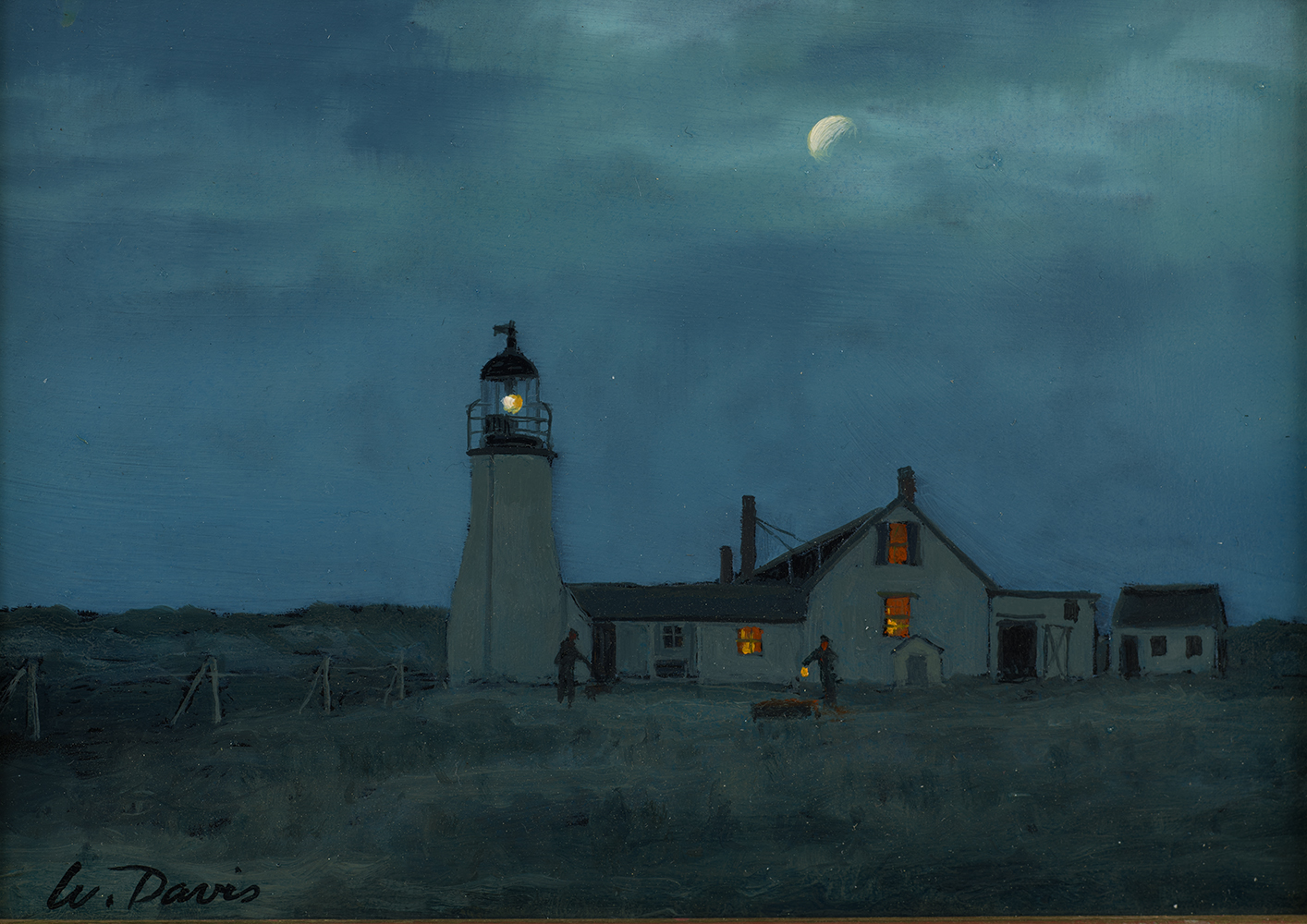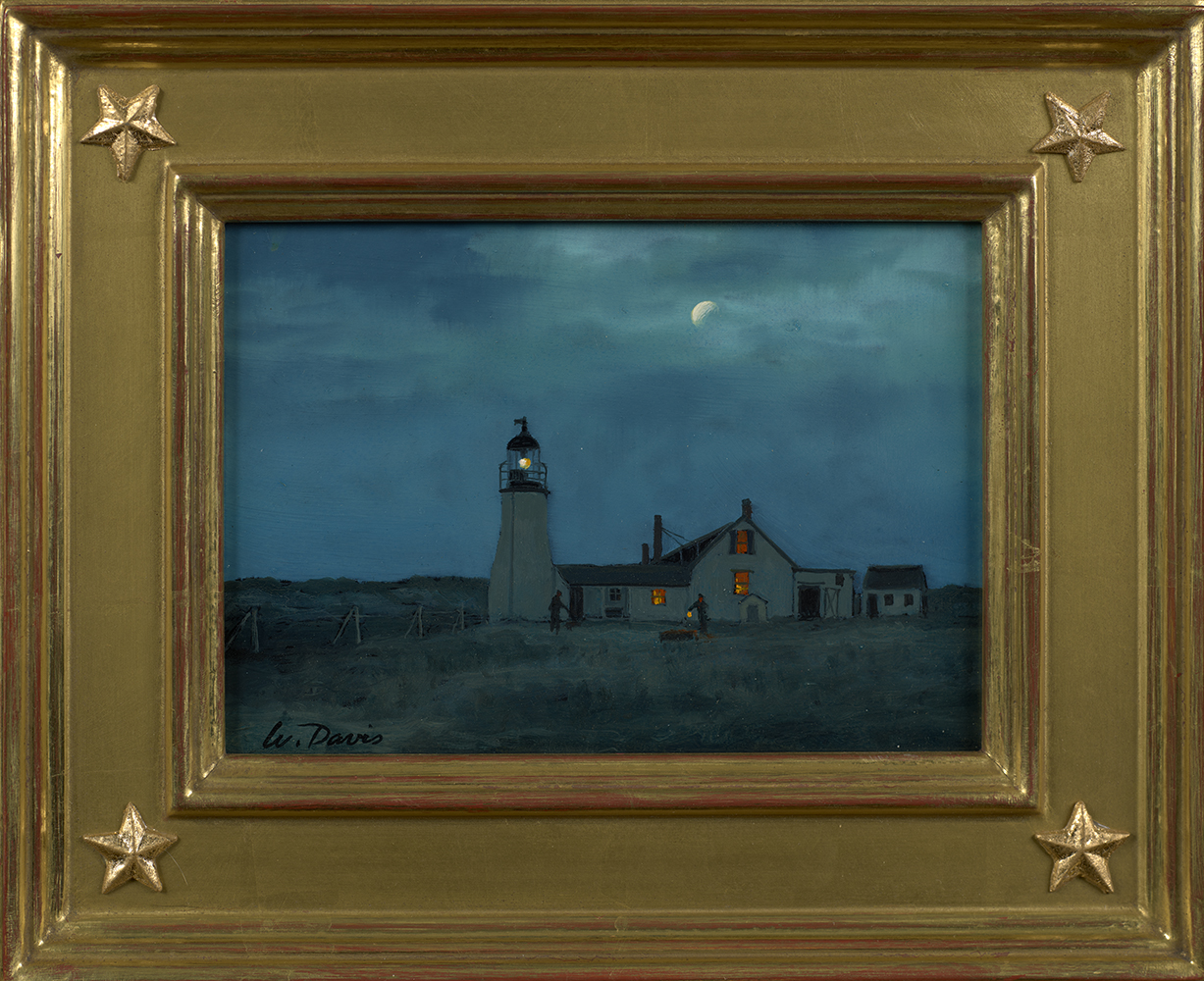William Davis
(Born 1952)
Race Point Lighthouse, Cape Cod, built 1816, c. 1850, 2020
Oil on panel
5 x 7 inches
Signed
BIOGRAPHY - William Davis (Born 1952)
Bill Davis was born the oldest of six children in Somerville, Massachusetts, a suburb of Boston, where his father worked in banking. Some of Davis's earliest memories, however, are associated with his grandparents' home, where he lived briefly as a child. The sound of trains on the nearby tracks and the smell of the city made a lasting impression, as did the occasional glimpse of tramps walking along the rail lines.
When Davis was four, the growing family moved to the town of Woburn, nine miles northwest of Boston where his father had accepted a new job. In the late 1950s, Woburn retained much of its rural character, as well as a number of historical houses dating from its founding as a colonial village in the 1640s. Davis's affection for pre-Revolutionary houses may well have had its roots in this experience. His only sister was born in Woburn, followed by another four brothers over the following years. With such a full house, Davis's parents decided to move to the town of Dennis on Cape Cod in 1959. There, his father started a heating and air-conditioning business, which became a thriving enterprise in the economic prosperity of the early 1960s.
A year later, the family moved into a house in Hyannis Port that was built in the 1740s. The painter remembers it fondly, noting that he could walk to the beach from there. Davis loved being by the sea, and began taking sailing lessons at age eight. By 1962, he had learned to sail the Beetle Cat boats, originally designed in 1921 by John Beetle in New Bedford, Massachusetts. These twelve-foot wooden catboats were developed specifically for fishing in the shallow—and sandbar riddled—waters off of Cape Cod. They are still made today and now have the distinction of being one of the few wooden sailboats still in production. [i] Davis's mastery of sailing would become an important part of his life, providing him with recreational pleasure as well as serving as a subject for his art.
Living in Hyannis Port in the early 1960s also had the unique attraction of being the location of the Kennedy family compound during John Kennedy's term as president. Along with the president came Secret Service agents—a fact that seems to have intrigued Davis and his friends far more than their proximity to the president of the United States. One of his friends lived next door to the Kennedy property; as Davis recalls, he spent most of the summer at his friend's house, where the two boys gradually persuaded the Secret Service agents to let them hang around occasionally. In fact, the agents eventually asked if the boys would like to became Junior Secret Service agents, a program that was initiated by President Dwight Eisenhower in the 1950s. [ii] Naturally, they eagerly agreed and promptly began learning about all that was required for such a responsible undertaking. And one evening as they were talking with the Secret Service agents on the dock, Jack Kennedy decided to join them.
Davis's years at Barnstable High School marked a turning point for him. It was there that he received his first art education in a four-year fine arts program under the direction of the painter Edward Bolton. Davis describes it as a "small class of dedicated students". In the tradition of the Ecole des Beaux-Arts in Paris, they copied from old masters such as Rembrandt, practiced drawing in many forms, and mastered a variety of media including pen & ink drawing, watercolor, and oil painting. Bolton was an accomplished artist in his own right, but his commitment to his work as a teacher and mentor was extraordinary. For Bill Davis, he offered encouragement, accountability and the occasional reminder that he had the talent to "do better".
After graduating in 1970, Davis attended Cape Cod Community College for a year, but soon found himself at loose ends. He considered applying to art school at the Boston Museum of Fine Arts but discovered that the curriculum offered little opportunity for him to continue developing his skills in traditional painting. In addition, the possibility of being drafted into the military—and being sent to Viet Nam— hung over his head. He thought about enlisting in the Coast Guard, but his decision was forestalled when the annual Selective Service lottery drafted only men with numbers up to 100; Davis's number was 112.
Without a clear direction, and with the promise of a red Corvette convertible in his future, Davis agreed to join his father in the heating and air-conditioning business. In the early 1970s, the company was flourishing, and Davis was soon managing the crews working on Nantucket Island. Working on Nantucket meant living there for the duration of the project, and not everyone was willing to take on that responsibility. For those who did, however, it meant a comfortable salary.
With steady work and a secure income, Davis settled into life in Hyannis and Nantucket. In 1976, he married Mary Elston and moved into yet another old house in Hyannis. And he began painting again in his free time, selling his first work in 1978. Painting quickly became his primary focus, and in 1983, he had his first exhibition, together with fellow artist and friend Elizabeth Mumford, at the Richard Bourne Company. Not only was the show well received, but it was attended by the well-known actress Lee Remick and Jackie Onassis.
The following year, Davis made two significant changes in his life. He stopped working with his father and he separated from Mary. He moved into a cottage with a windmill attached to it on the Bass River in South Yarmouth. Although the tour boats always pointed out the "windmill cottage" as they cruised by, Davis found it a congenial location to concentrate more fully on his painting.
Over the next few years, the artist focused on establishing his career as a marine painter. He traveled throughout New England, capturing iconic images such as Niagara Falls as well as quieter scenes in the mountains and marshes of the region. His study of American Luminist painters such as Fitz Hugh Lane and Martin Johnson Heade is evident in these works. Equally important was Davis's development of his reputation in the art world. With the help of a friend, he was able to place some of his paintings at auction at Eldred's Auction Gallery in East Dennis, Massachusetts, which helped him to establish a sales record as a professional artist.
The clearest sign of his successful entry into the art world occurred in 1987 when he became the first person ever to have a solo show at the prestigious Mystic Maritime Galley at the Mystic Seaport Museum in Connecticut. All twenty of his works sold at the opening reception. Two years later, he received the 1989 Award of Excellence at the Mystic Maritime Gallery International Show. He continued to expand his range of gallery exhibitions in Massachusetts throughout the 1990s, even receiving a second-place award at the Copley Society of Art exhibition in Boston.
Davis's personal life was also transformed when he met Judy Machon, who worked at Eldred's Auction Gallery. She and Davis soon became a couple, with Davis also becoming a father to her two young daughters. They married in 1995 and moved into the Hyannis house that Davis had purchased during his first marriage.
Shortly after his marriage to Judy, Davis received a commission for a very large painting of a yacht owned jointly by Michael Orvitz, president of Walt Disney Company from 1995-97, and Michael Eisner, then CEO of Disney. Although the scale of the painting was extraordinary, Davis's knowledge of boats and his scrupulous attention to detail made him an ideal artist for the project. Having such well-known clients was also a welcome addition to the painter's portfolio.
By the late 1990s, Davis decided to explore the process of plein air painting, partly as a result of his friendship with Joseph McGurl and Donald Demers, who were already enthusiastic proponents of the approach. Together, the three artists spent a portion of 1998 traveling New England and painting at locations that were frequented by the American Luminist painters in the mid-nineteenth century. Davis remarks that he was particularly intrigued by the work of Frederic Edwin Church (1826-1900), noting that the Hudson River School painter's handling of light and dark taught him how to create the contrasts that he sought between the colors in his own work.
The result of the Hudson River expedition was a very successful exhibition entitled The New American Luminists Revisit the Native Landscape at Tree's Place in Orleans, Massachusetts. Two years later, the three artists reprised the Luminist theme with another exhibition—The New American Luminists, 2nd Show—at Tree's Place in 2000. The following spring, Davis received his first major coverage in the April issue of American Artist Magazine; he not only provided the cover illustration but was the subject of an in-depth article about his work.
The twenty-first century opened with new opportunities and a vastly expanded scope of work for Davis. His paintings were being shown not only in New England galleries, but in New York, Florida, and California; and he was developing an international client base. He traveled more widely—to the Caribbean and Europe—and painted in a variety of locations. Eventually, he and Judy sold the house in Hyannis and moved to a more secluded spot near Harwich. This time, they built a new house, incorporating the much loved charms of their previous eighteenth-century home, but with more contemporary amenities—and a larger studio. Davis is also quick to point out that the new place is "in the country on a dirt road." And it has a pond with a beach.
In his recent work, Davis has continued to paint sailboats, but now they are often nineteenth-century sailing ships—three-masted schooners or whaling ships—the kind of vessels that were once a common sight in the seaports of Massachusetts. Old steamboats also make an occasional appearance chugging up the Hudson River or steaming into Provincetown on a misty evening.
Davis has also been exploring nocturnal compositions. He credits the work of the British painter John Atkinson Grimshaw (1837-1893) as his initial inspiration for this type of painting, but it is clear that he has developed his own interpretation of the evening mood. A series of paintings feature solitary lighthouses at night—sometimes shown as a burst of light surrounded by the blackness of the Atlantic Ocean or glowing in the last rays of a brilliant sunset. Other nocturnes focus on tonal landscape images: a misty winter scene in shades of blues and dark greens with the suggestion of light from a distant house across a snow-covered pond; or the brilliant red of autumnal leaves against a rainy group of trees. Like James McNeill Whistler, that other American painter of Nocturnes, Davis has found his way into an almost abstract evocation of a place that depends on creating not a plethora of minute detail, but an evocative sense of mood.
Janet Whitmore, Ph.D.
Memberships
Fellow Artist Member, The American Society of Marine Artists
Artist Member, The Guild of Boston Artists
Artist Member, Salmagundi Club, New York, NY
Board of Trustees, Cape Cod Maritime Museum
Notes
[i] For more information about the Beetle Cat boats, see http://www.beetlecat.org/history.php
[ii] The Junior Secret Service agent program still exists, and is now managed by the National Parks Department; for more information, see https://www.nps.gov/features/eise/jrranger/secret8.htm


